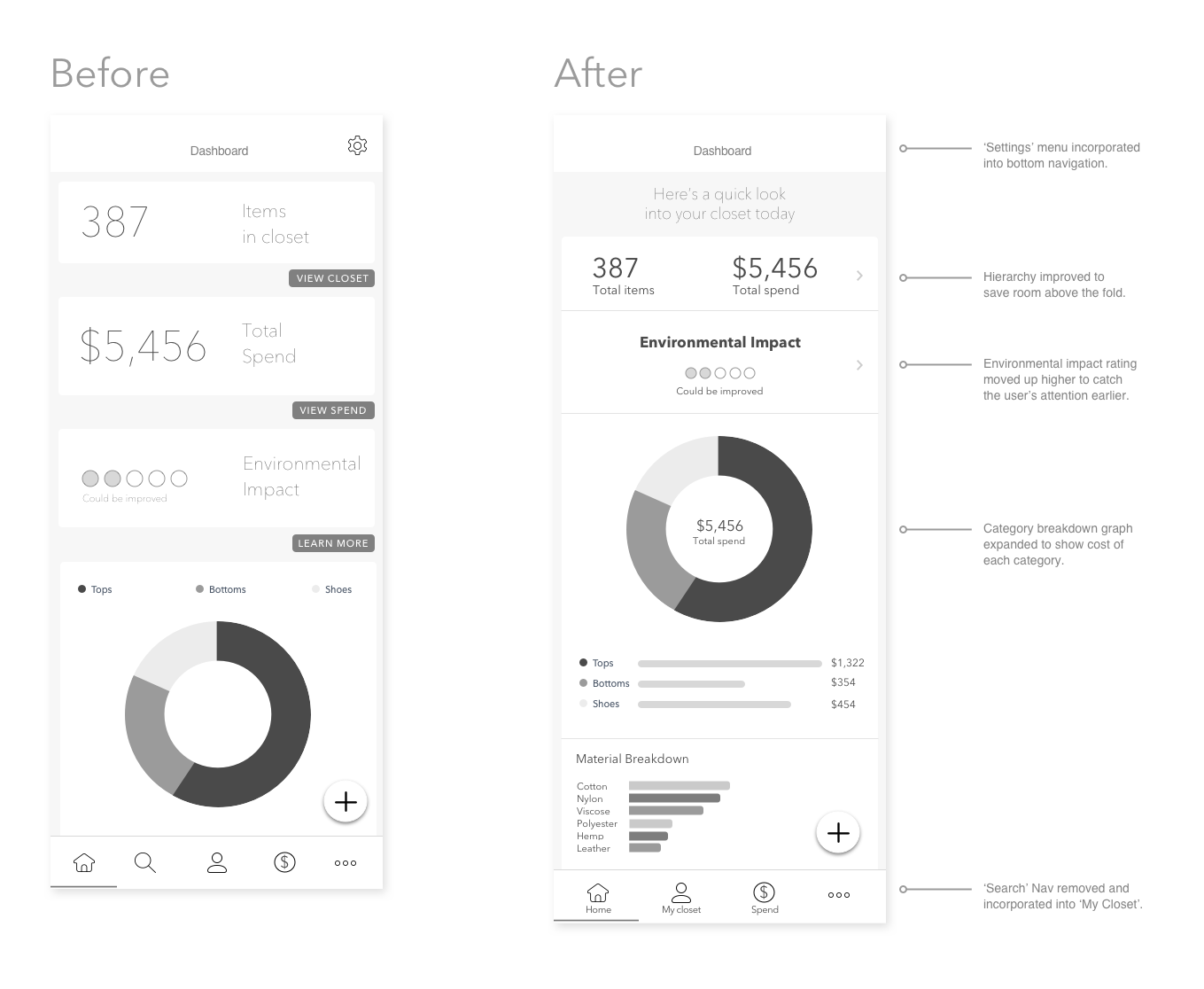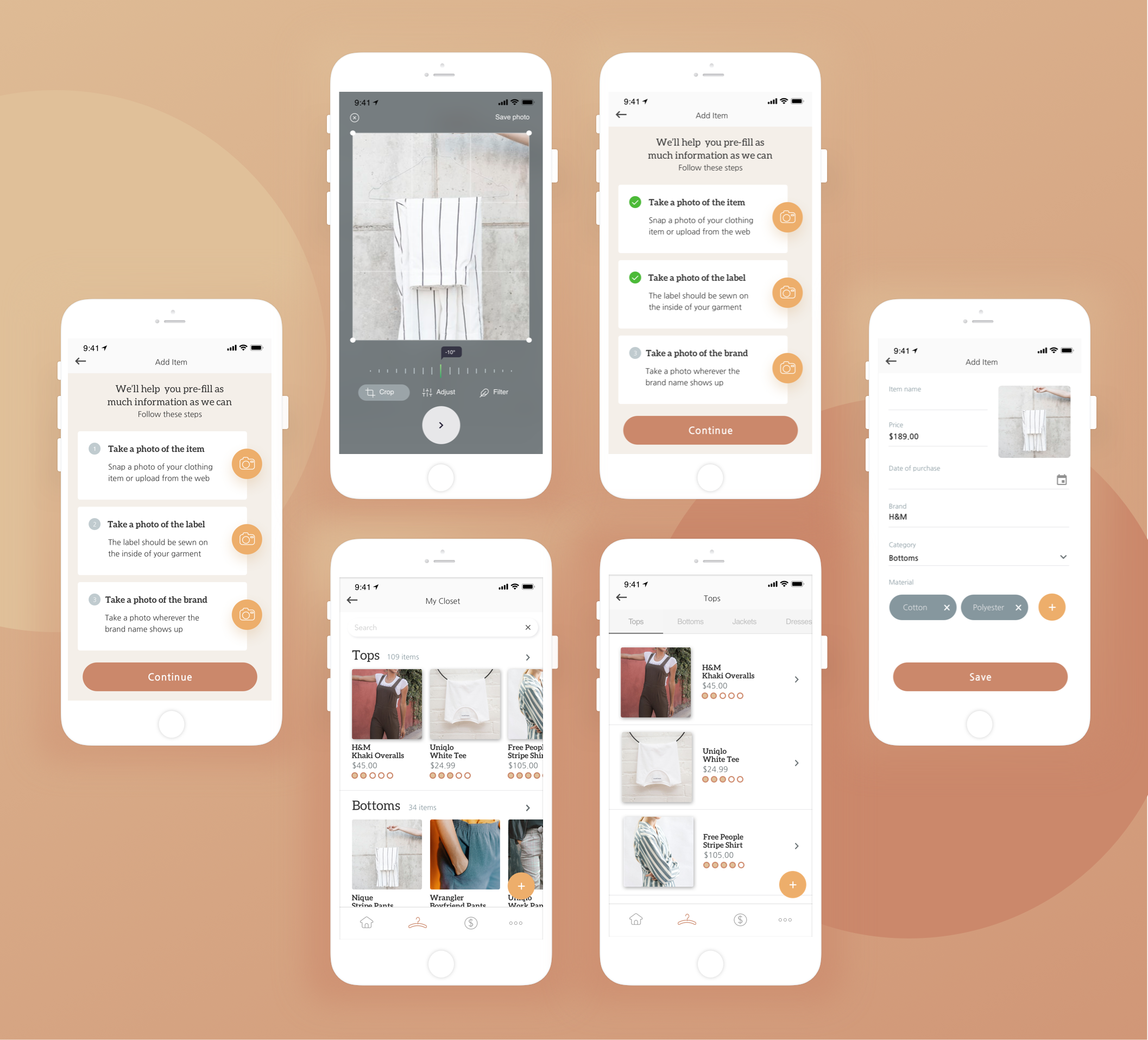Final UI design of mobile app
Overview
This is a design concept to tackle the environmental and ethical impacts of fashion.
What’s the problem?
The low prices of fashion items encourages more impulse purchase which produces more waste in the environment.
Consumer education and awareness is growing, but still slow.
How can we help people to shop more consciously and raise awareness of fashion’s environmental impact?
What was the outcome?
A mobile application concept to track what’s in a user’s current wardrobe.
The goal is to help consumers make better purchase decisions in the future through reflection and education.
Discovery & Research
The world now consumes a staggering 80 billion pieces of clothing each year. This is up 400% from two decades ago. Only 10% of the clothes people donate to charity or thrift stores get sold.
The rest end up in landfills or flooding markets in developing countries like Haiti where they are bought by the box and kill the local industry. (Source: The True Cost)
My first step was to begin with research and delve deeper in the topic to identify user needs.
What i wanted to know:
To what extent do consumers consider the environmental and ethical impact of their clothing purchases aka. do people care?
What are the factors that influence decision making during clothing purchase?
How consumers currently gather information about the sustainable and ethical practices of clothing brands.
i targeted 2 main consumer groups:
Consumers who are not aware of what they’re buying and the impact it has on the environment. They buy with the intention of accessing a new fashion item cheaply.
Conscious consumers who care about how and where their clothes are made but find it difficult to find out if a brand is ethical or sustainable.
Research Methods
Survey: to determine influencing factors when purchasing clothing.
Interviews: to find out in detail the purchase behaviour and process of the consumer.
Synthesizing Research and Findings
Survey FINDINGS (samples size:25)
Awareness and education is the biggest issue.
The ethical and sustainable impacts of purchasing clothes is the least important aspect in their decision process.
When people do want to find out more, it often requires hours of research to find the right information about a brand.
They don’t buy a lot of clothes, they like sales.
Quality and price are important to them.
“I don’t think about how or where the clothes are made when I buy clothes”
“There’s a lot of clothes in my wardrobe that I don’t wear. I forget what I’ve got until I do a clean up.”
“I want to buy better quality clothes but it has to be worth the price and I want to know the material is long lasting.”
Interview Findings
Consumers don’t tend to think about the environmental impact of clothing purchases
Consumers prefer to save money and purchases clothing during sales
Value is very important when purchasing clothing. Does the price and quality match?
Receiving email newsletters is often a trigger to spontaneous clothing purchase
Target Audience
Females who purchase clothing and like to save money and buy less.
They have minimal knowledge on the environmental impact of fashion.
This group focuses more on financial goals rather than sustainable goals.
User Goals:
Buy less clothes
Declutter and simplify wardrobe
Save money on clothing
Buy good quality clothing
Know the material source of the clothing
Customer Persona:
Customer persona
Redefining the Problem
I found out that environmental impact and sustainability is not an influencing factor to purchasing clothing for most consumers.
Problem statement
Michelle needs a way to track what’s in her current wardrobe and her future clothing purchases because she wants to save money by buying less items but better quality clothing.
Hypothesis
We believe that by tracking what’s in her current wardrobe and any new items she purchases, she will save money and reduce clothing wastage.
Ideating the Solution
Storyboard sketch based on pain point of not knowing what’s in your wardrobe.
Storyboard sketch based on pain point of not knowing what the material and fabrics mean in terms of quality.
User CentRed Design Canvas (By The Rectangles)
Before sketching solutions, I decided to use the UCDC to help me capture all the important findings and information on one page.
User Centered Design Canvas
Initial Solution Sketches for Mobile Application
How might a mobile application help Michelle track the items in her wardrobe and educate her about the environmental aspects of her clothing purchases?
Developing an MVP using:
Feature prioritisation list
Two-by-two matrix (Impact/Expectation)
Mobile Application Sketches:
Wireframes & User Flow
The concept: Conscious Closet
A mobile application that lets users log and track their items in the closet.
The application synthesises brand and fabric information to educate the user on the environmental impact of their wardrobe through a simple rating.
Wireframe/User flow
Initial testing


Results from testing:
Before:
The dashboard hierarchy was a weakness in the first wireframe.
In the ‘My closet’ screen, users made a note that there is no motive to click into the item more than once because there would be no new information shown after the first time they log the item.
After:
I introduced a two column grid to show ‘total items’ and ‘total spend’ on one line. This saved space and allowed me to push ‘Environmental impact’ up so that it is more prominent when the user opens the app and lands on the dashboard.
I introduced a ‘cost per wear’ function so users can log how many times they’ve worn an item. This provides another level of analysis of a user’s wardrobe which encourages the user to return to the item screen whenever they wear the item again.
High Fidelity Prototype
Know your closet.
Know your impact.
Onboarding and register screens.
Snapshot of your closet
This is the homepage of the mobile app which shows you a snapshot view of your closet including: number of items, total spend of your closet, an environmental impact rating, category and material breakdown. The user can click into any of the sections to get more detailed information. The goal of this is to provide a quick but important insight into a user’s closet to help them reflect on their purchase decisions.
User goal: Save money, know what’s in your wardrobe.
Learn about the clothes you own to help you make better decisions.
Log how many times you’ve worn an item to calculate your cost per wear. Learn about the environmental impact of your clothes based on public brand information and material and fabric insights.
User goal: Buy more quality clothing (through education of material and fabric), declutter and simplify (knowing cost per wear lets you review what items you are not wearing)
Log items in your closet.
To add an item in your closet, you will be prompted to take a photo of the item, the label and the swing tag. This will auto-generate information needed for the item report. The user can then edit or add information manually before saving the item to their closet. The user can also view all their items in the closet under the ‘My closet’ navigation tab.
Learnings
This is a concept that needs validation for feasability with the tech team. A discussion needs to be had on how can we integrate available data about the brands and material to auto-generate a report on the ‘items’ page.
My next steps would involve more testing and user interviews to improve the usability and experience of the application.
Future features:
A search function that allows users to research a brand before they purchase.
Bulk add function so new users can easily add multiple items in their wardrobe at a time to shorten upload time.
Customer reviews of the brand and item
Factory and labour insights.
Show alternate brands or fabrics that are more environmentally friendly.
Education and resource function that can help users make more informed choices the next time they purchase clothing.
Outfit or capsule wardrobe building function.











